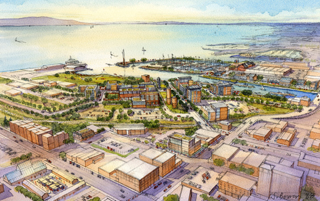
DJC.COM
November 19, 2009
Bellingham embarking on ambitious waterfront plan
Port of Bellingham

Bennett
|
In some parts of Puget Sound, the economic downturn has brought real estate development to a screeching halt. But in Bellingham the city and the Port of Bellingham are using this transition time to push their 220-acre waterfront redevelopment project, the Waterfront District, to center stage as the economic recovery takes hold.
The local governments and residents are unified in their focus on reclaiming their waterfront after years of industrial use. Past industrial practices have left environmental problems that will require extensive cleanup efforts. Yet a clear vision and plan is almost in place to ensure that the cleanup and redevelopment will result in a project that illustrates smart growth and sustainability.
An urban waterfront
The entire district is expected to take 30 to 40 years to build out. Plans call for up to 6 million square feet of residential, commercial, marine trades, hospitality and educational uses.

Image by Stephanie Bower At build-out, Bellingham’s Waterfront District could house up to 6 million square feet of residential, commercial, hospitality, educational and marine-industry space. The city and port have streamlined their permitting processes to attract development. |
Despite the recession, the port and city are working together to complete the master planning, development agreements and environmental analysis.
New public access to restored shorelines will come online as the port deeds 33 acres of land to the city for waterfront parks and trails. The city has also agreed to build streets and utility infrastructure. The project will be developed in phases as absorption demands.
The port plans to sell much of the land to developers so it can recoup its cleanup costs. Public amenities like parks, a new marina and an existing shipping terminal will remain under port and city ownership.
The overall planning goal is for the port and the city to complete the rezoning and master plan effort in mid-2010, with formal adoption of regulatory and interlocal agreements toward the end of 2010.
The port, city and state public investment in cleanup, shoreline restoration, roads, utilities, parks and other infrastructure is estimated at well over $200 million, with half of the funding coming from federal and state grants. This public sector investment is intended to attract the much larger private investment upon which the success of the project depends.
Full build-out is estimated at $2 billion-$3 billion. Over the coming years, this partnership between the public and private sectors will provide the community with an exciting urban waterfront with great public access that is pedestrian- and bicycle-oriented, featuring far more than the average amount of open space for a development of this size.
The port and city recognize that early investment in these public amenities, along with predictable development regulations, is essential to attracting private investment.
No surprises
The Port of Bellingham, which owns most of the property in the Waterfront District, understands that investors and developers are attracted to projects with predictable regulations and permit procedures.
When the port acquired the majority of the property from the Georgia Pacific Corp. in 2005, it recognized that business as usual would not work in redeveloping a brownfield property. That same year, the port and city signed an interlocal agreement to streamline the permitting process on the waterfront “beyond the normal city process” to provide predictability, consistency and efficiency for investors.
When the property is marketed in late 2010, land-use entitlements will be in place and it is hoped that proposed projects will need only a building permit and a review for architectural consistency. The goal is to offer a relatively simple permitting process that will help attract investment and open the doors to innovators.
Waterfront campus
Western Washington University is committed to expanding with a new waterfront campus. Through a port-WWU entity named Western Crossings Development, the opportunities for public/private partnerships to create the campus buildings, along with adjacent commercial development, will bring high-quality investment and create a bustling atmosphere with jobs, people and events.
Numerous studies show that universities are economic development drivers due to populations that live near campuses: Many businesses and corporate campuses like to locate near college campuses for the educated workforce and quality of life. This joint development entity will be seeking private developers once the master plan and rezone are adopted.
Innovation hub
The state has designated the Waterfront District development area as an Innovation Partnership Zone. These zones are strategically located around the state as hubs for research partnerships between industry, innovators and educational institutions.
To launch the Bellingham zone, the state has invested $1 million toward creation of a waterfront Technology Development Center. The center opened this fall with Western Washington University and Bellingham Technical College locating research and training programs there, already partnering with a private shipbuilding company to design new hull materials. The goal is to attract additional companies for public/private research partnerships in the district.
The Waterfront District will be a neighborhood of the future, featuring sustainable design and innovative energy features such as passive solar gain, access to active public spaces, a reduced parking footprint and compact development.
From revitalizing an urban brownfield to creating significant new marine habitat to undertaking a comprehensive environmental cleanup, every aspect of this project showcases the principles of sustainable urban development and environmental stewardship. It is anticipated that larger parcels of land will be available to builders whose innovation will help define how cities of the future — and specifically urban waterfronts — are built to reflect these goals.
One of the centerpieces of the development is the port’s new 350-slip Clean Ocean Marina, which will be built in what once was a 37-acre contaminated wastewater lagoon. This downtown marina, scheduled to open in 2015, will actually improve the environment with significant habitat restoration and public access around the breakwater.
The Waterfront District is registered under the U.S. Green Building Council’s LEED for Neighborhood Development pilot program, one of many resources being used to guide master planning.
The port also is working with the state Department of Ecology on several environmental cleanup plans so that historic contamination can be dealt with as part of the redevelopment. Under agreements with Ecology, the port will retain responsibility for managing contaminated soils, even for properties that will be marketed to the private sector.
Seeking developers
While property in the Waterfront District will not be available for sale until late 2010, potential market opportunities are emerging. The port is encouraging developers and investors to contact it to learn more about the project and to sign up for regular project updates.
As the planning and rezoning effort transitions into the actual redevelopment, the port anticipates opportunities becoming available in a wide range of uses:
• Marine trades businesses and development alongside the new downtown marina.
• Mixed-use developments alongside downtown Bellingham featuring urban housing, commercial and retail buildings.
• Institutional, educational and commercial developments, including campus buildings for WWU, which is seeking a long-term leasing option.
Lydia Bennett is the director of real estate for the Port of Bellingham. She has been involved in the commercial real estate industry in the Pacific Northwest for more than 20 years.
Other Stories:
- Magnolia Bridge complicates pier project
- Placid park belies a major engineering effort
- 21st-century waterfronts: What makes them work?
- Bellevue reconnecting with its waterfront
- Planning a shoreline project? Win over the public first
- Kennewick island lighthouse a beacon for downtown
Copyright ©2009 Seattle Daily Journal and DJC.COM.
Comments? Questions? Contact us.